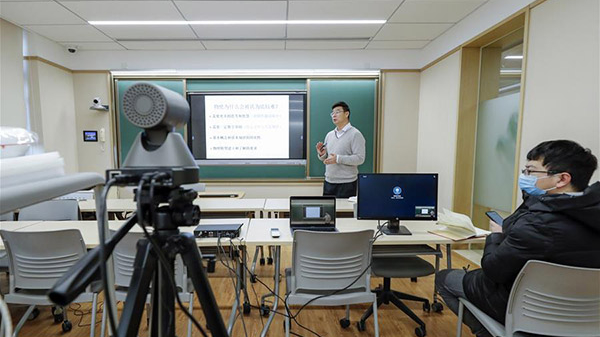
Huang Jianbin, a teacher at Peking University, uses online educational system "Classin" to teach physical chemistry, in Beijing, February 17, 2020. /Xinhua Photo
Huang Jianbin, a teacher at Peking University, uses online educational system "Classin" to teach physical chemistry, in Beijing, February 17, 2020. /Xinhua Photo
Editor's note: Wang Yan is a senior specialist and the director of the Department for International Exchange, National Institute of Education Sciences. The article reflects the author's views and not necessarily those of CGTN.
This week, around 180 million students in China should have returned to school and continued their campus life for the spring semester. But as the coronavirus outbreak continues, the Chinese government remains very strict about measures to contain the spread. As a result, students are required to stay home for quarantine, but they're not away from education.
Since the beginning of the quarantine, many of them have started online learning through various online courses and programs, offered by the government, education institutions and tutoring institutions, after the Spring Festival.
The learning fever is running high. It might be explained by the schools' aspiration for their students' performance in ensuing examinations (including high school entrance examination and college entrance examinations), Chinese students' usual diligence, and learning for fun under the quarantine as well as their enthusiasm and curiosity for new ways of learning.
Nonetheless, holiday is holiday. On February 4, the Ministry of Education issued a "Reminder" to forbid offering online courses for new mandatory subjects before the pre-scheduled starting date of the new semester, to make sure students focus on assignments for winter vacation and are not overwhelmed by online learning burden.
On the other hand, the Ministry encouraged courses on subjects related to coronavirus, mental health counselling as well as arts and sports for entertainment to maintain study-life balance.
For China, the outbreak is a battle and the colleges are also at the front line, as one infected student might affect many other students and their families.
The Minister of Education Chen Baosheng stressed it is imperative to take into consideration the worst scenario and take resolute measures in order to prevent the outbreak in colleges. Students are not allowed to return to campus without approval, and non-faculty are forbidden from entering the campus.
On the other hand, "Class stops, yet not teaching and learning" becomes the main objective of the education sector.
As the epicenter of the outbreak, central China's Hubei Province is particularly in need of educational assistance. To meet such needs, the People's Education Press offered three-month digital textbooks and application services; and the National Center for Education Technology transmitted 6,806 national courses to Hubei for schools with internet yet lacking quality core teaching resources.
Schools are given high priority when financial resources nationwide are tightening. The ministries of education and finance issued a policy (circular), requiring financial sector to assess the financial gaps of education institutions to cope with the outbreak and secure the budget to fill the gap, including allowing local governments to use prior earmarked funds for outbreak control resources. "A green channel" was also established for quality and efficiency of procurement during the emergency.
The education systems reacted very fast. In the higher education sector, by February 2, 22 online curriculum platforms opened 24,000 online courses for higher education institutions to choose from, including 1,291 national excellence courses and 401 national virtual simulation experimental courses, covering 12 undergraduate programs and 18 tertiary vocational programs.

Hu Xiaoqian, a teacher at Tsinghua University, uses online educational system to teach a baseball class, in Beijing, February 17, 2020. /Xinhua Photo
Hu Xiaoqian, a teacher at Tsinghua University, uses online educational system to teach a baseball class, in Beijing, February 17, 2020. /Xinhua Photo
On February 17, Tsinghua University started its new semester with a national flag raising ceremony, the campus is vacant, yet online classrooms are full. A total of 4,254 courses have been planned for this semester, involving 2,681 faculty members (professors and lecturers) and 25,091 students, with 3,923 courses being offered online. On the first day of the new semester, 155 courses opened in 31 colleges and schools.
On the same day, a national internet cloud platform opened, offering digital learning resources to students in primary and secondary schools free of charge. It was developed through multi-sectoral efforts and public-private partnership, attracting resources from the Ministry of Education, the Ministry of Industry and Information Technology, Aliyun, China Telecom and China Mobile, Huawei, among others. With 7,000 servers, 90T bandwidth, the platform can accommodate 50 million students learning online simultaneously.
The cloud learning resources consist of six modules: epidemic prevention education, moral education, thematic education, curriculum learning, digital textbooks, and film and television education. It encompasses 12 subjects in lower and upper secondary education, with 169 classes available in the first week. The China Education Television Station will live broadcast parts for primary and secondary schools, 75 classes each week, which will also reach remote and rural areas.
Governments and schools worked out detailed plans to cope with the challenges. Taking Haidian District of Beijing as an example, winter vacation was extended. The municipal government, district authority and schools jointly developed students' learning resources for this period. During the extended vacation, the teachers are working with students to formulate daily study plans, online courses are offered with longer breaks and instructions to control the time that students spend watching the computer screen.
Like in the field of health, China is making huge efforts to fight against what has become a huge education challenge. It is not easy at all to ensure over 200 million students continue their learning given the limited conditions under quarantine versus substantial economic costs. It proves China's commitment to education and its tremendous potential in handling the challenges in education governance, which relates to people's well-being, productivity increases, wealth creation, and welfare improvements.
To educators and students, this is a process of learning. While we hope the outbreak ends soon, the students are acquiring new academic, social and emotional skills, and more importantly they are learning to acquire the skills with cutting-edge technology and diverse delivery ways.
This hopefully would accelerate modernization of education system, and also better prepare students by increasing their capacity and abilities to face new challenges in a rapidly changing world.
(If you want to contribute and have specific expertise, please contact us at opinions@cgtn.com.)